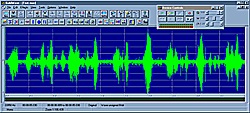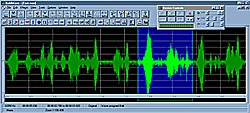The sole aim of the metaphor
is to call up a visual image. Aristotle |
How To Create A Sound File On Your Computer For Reverse Analysis
 A
minimum amount of equipment is necessary to analyze reverse speech on the computer. What
you will need is a personal computer with sound card, speakers (and/or headphones), and
microphone, a cassette recorder, and a simple sound editing program. The quality of the
sound you get is mainly dependent on the quality of the soundcard and speakers, however if
you already have a computer that will play a sound and you can understand forward speech
with it, you can try your hand at finding reversals.
A
minimum amount of equipment is necessary to analyze reverse speech on the computer. What
you will need is a personal computer with sound card, speakers (and/or headphones), and
microphone, a cassette recorder, and a simple sound editing program. The quality of the
sound you get is mainly dependent on the quality of the soundcard and speakers, however if
you already have a computer that will play a sound and you can understand forward speech
with it, you can try your hand at finding reversals.
The reversals for this site were done on a P-166MMX with 80MB of EDO RAM with Creative's AWE64 Gold card with 4MB RAM for the soundcard and Altec Lansing's ACS48 speaker system. GoldWave software, available on the Internet as shareware, is a good sound editing program that will do waveform reversals.
To input sound into the computer place the computer microphone near the cassette recorder. Turn on the cassette recorder (you can also use a TV or speak directly into the mic). Set the computer software to record. The sound will be input via the microphone and create a waveform that will look similar to Figure 1. You will have to play around a little bit with the volume level of the cassette recorder and the placement of the microphone in order to get a good waveform. Placement of the microphone is important to prevent noise resulting in unwanted hums in the sound file. It is not recommended that you use any filtering process available in the software as it may degrade the clarity of the reversal.
Once you have recorded your selection into the computer, just select REVERSE (generally found in the EFFECTS menu). Play the file and try to pick out the reversals. You must listen, as there is no way to visually pick out the reversals. Reverse speech is much faster than forward speech so it is helpful to adjust the speed of the playback. I generally start at about 95% and play the file until I find something that I can make out. Most sound editing programs have an indicator so you can follow where you are in the waveform as you are listening to it. By highlighting a selection you can concentrate on a promising segment of the waveform. Figure 2 shows a selection (highlighted in blue) typical of reverse speech containing three to five words.


